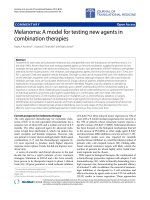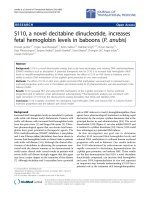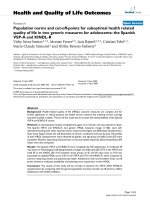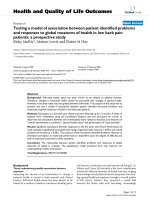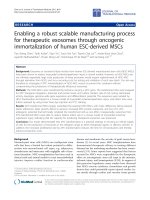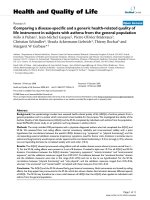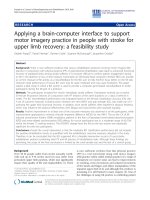báo cáo hóa học:" Enabling a robust scalable manufacturing process for therapeutic exosomes through oncogenic immortalization of human ESC-derived MSCs" doc
Bạn đang xem bản rút gọn của tài liệu. Xem và tải ngay bản đầy đủ của tài liệu tại đây (1.28 MB, 10 trang )
RESEARC H Open Access
Enabling a robust scalable manufacturing process
for therapeutic exosomes through oncogenic
immortalization of human ESC-derived MSCs
Tian Sheng Chen
1
, Fatih Arslan
2
, Yijun Yin
1
, Soon Sim Tan
1
, Ruenn Chai Lai
1,3
, Andre Boon Hwa Choo
4
,
Jayanthi Padmanabhan
4
, Chuen Neng Lee
5
, Dominique PV de Kleijn
2,6
and Sai Kiang Lim
1,5*
Abstract
Background: Exosomes or secreted bi-lipid vesicles from human ESC-derived mesenchymal stem cells (hESC-MSCs)
have been shown to reduce myocardial ischemia/reperfusion injury in animal models. However, as hESC-MSCs are
not infinitely expansible, large scale production of these exosomes would require replenishment of hESC-MSC
through derivation from hESCs and incur recurring costs for testing and validation of ea ch new batch. Our aim was
therefore to investigate if MYC immortalization of hESC-MSC would circumvent this constraint without
compromising the production of therapeutically efficacious exosomes.
Methods: The hESC-MSCs were transfected by lentivirus carrying a MYC gene. The transformed cells were analyzed
for MYC transgene integration, transcript and protein levels, and surface markers, rate of cell cycling, telomerase
activity, karyotype, genome-wide gene expression and differentiation potential. The exosomes were isolated by
HPLC fractionation and tested in a mouse model of myocardial ischemia/reperfusion injury, and infarct sizes were
further assessed by using Evans’ blue dye injection and TTC staining.
Results: MYC-transformed MSCs largely resembled the parental hESC-MSCs with major differences being reduced
plastic adherence, faster growth, failure to senesce, increased MYC protein expression, and loss of in vitro
adipogenic potential that technically rendered the transformed cells as non-MSCs. Unexpectedly, exosomes from
MYC-transformed MSCs were able to reduce relative infarct size in a mouse model of myocardial ischemia/
reperfusion injury indicating that the capacity for producing therapeutic exosomes was preserved.
Conclusion: Our results demons trated that MYC transformation is a practical strategy in ensuring an infinite supply
of cells for the production of exosomes in the milligram range as either therapeutic agents or delivery vehicles. In
addition, the increased proliferative rate by MYC transformation reduces the time for cell production and thereby
reduces production costs.
Background
Mesenchymal stem cells (MSCs) are multipotent stem
cells that have a limited but robust potential to differ-
entiate into mesenchymal cell types, e.g. adipocytes,
chondrocytes and osteocytes, with negligible risk of tera-
toma formation. MSC tra nsplantation has been used in
clinical trials and animal models to treat musculoskeletal
injuries, improve cardiac function in cardiovascular
dis eas e and ameliorate the severity of graf t-versus-host-
disease [1]. In recent years, MSC transplantations have
demonstrated therapeutic efficacy in treating different
diseases but the underlying mechanism has been contro-
versial [2-9]. Some reports have suggested that factors
secreted by MSCs were responsible for the therapeutic
effect on arteriogenesis, stem cell crypt in the intestine,
ischemic injury, and hematopoiesis [9-20]. In support of
this paracrine hypothesis, many studies have observed
that MSCs secrete cytokines, chemokines and growth
factors that could potentially repair injured cardiac tis-
sue mainly through cardiac and vascular tissue growth
* Correspondence:
1
Institute of Medical Biology, A*STAR, 8A Biomedical Grove, 138648
Singapore
Full list of author information is available at the end of the article
Chen et al. Journal of Translational Medicine 2011, 9:47
/>© 2011 Chen et al; licensee BioMed Central Ltd. This is an Open Access article distributed under the terms of the Crea tive Commons
Attribution License ( which permits unrestricted use, distribution, and reproduction in
any medium, provided the original work is properly cited.
and regeneration [21,22]. This paracrine hypothesis
could potentially provide for a non-cell based alternative
for using MSC in treatment of cardiovascular disease
[23]. Non-cell based therapies as opposed to cell-based
therapies are generally easier to manufacture and are
safer as they are non-viable and do not elicit immune
rejection.
We have previously demonstrated that culture med-
ium c onditioned by MSCs t hat were derived from
human embryonic stem cells (HuES9E1 MSCs) or fetal
tissues could protect the heart from myocardial ische-
mia/reperfusion injury and reduce infarct size in both
pig and mouse models of myocardial ischemia/reperfu-
sion (MI/R) injury [24-27]. Subsequent studies demon-
strated that this cardioprotection was mediated by
exosomes or microparticles of about 50-100 hmindia-
meter and these microparticles carry both protein and
RNA load [24-28]. These exosomes could be purified as
a population of homogenously sized particles by size
exclusio n on H PLC and reduced i nfarct size in a mouse
model of MI/R injury at about a tenth of the dosage of
the conditioned medium [24,25].
The identification of exosomes as the therapeutic
agent in the MSC secretion could potentially provides
for a biologic-rather than cell-ba sed treatment modality.
Unlike cells, exosomes do not elicit acute immune rejec-
tion and being non-viable and muc h smaller, they pose
less safety risks such as the formation of tumor or
embolism. Furthermore unlike cell-based therapies
where there is a need to maintain viability, manufacture
and storage of non-viable exosomes is l ess complex and
therefore less costly. Besides being therapeutic agents,
exosomes have been advocated as “natural” drug deliv-
ery vehicles [29]. These lipid vesicles could be loaded
with therapeutic agents and b e used to deliver the
agents in a cell type specific manner. hESC-MSCs could
be the ideal cellular source for the efficient production
of exosomes. We have demonstrated that these cells
could be grown in a chemically defined medium during
the production and harvest of exosomes and these exo-
somes could be purified by HPLC to generate a popula-
tion of homogenously sized particles [27]. Another
advantage is that these cells were derived from hESC, an
infinitely expansible cell source.
While hESC-MSCs are also highly expansible in cul-
ture, they unlike their parental hESC can undergo only
a finite number of cell divisions before their growth is
arrested and they senesce. Therefore there will be a
need to constantly derive new b atches of MSCs from
hESCs to replenish the cell source o f exosomes with
each derivation nec essitating recurring cost of deriva-
tion, testing and validation. To circumvent this need for
re-derivation and ensure an infinite supply of identical
MSCs for commercially sustainable production of
exosomes as therapeutic agents or delivery vehicle, we
explore the use of oncogenic transformation to bypass
senescence. Oncogenic transformation could pot entially
alter the cell biology and affect the production or the
properties of the exosomes. It was previo usly reported
that transfection of v-MYC gene into fetal MSCs
immortalized the cells but did not alter the fundament
characteristics of these MSCs [30]. Here we transfected
the MSCs wit h a le ntiviral vector containing the MYC
gene which encodes for the MYC protein into the pre-
viously described hESC derived MSCs (HuE S9.E 1 MSC)
at passage 21 (p21) and passage 16 (p16) to generate a
pooled cell line and three independently derived clonal
cell lines respectively [26]. We examined the trans-
formed cells according to the ISCT minimal defining
criteria for MSCs namely plastic adherence, surface anti-
gen profile of CD29
+
,CD44
+
,CD49a
+
CD49e
+
,CD90
+
,
CD105
+
,CD166
+
,MHCI
+
,CD34
-
,CD45
-
and HLA-
DR
-
, and potential to differentiate into adipocytes, chon-
drocytes and osteocytes [31]. The secretion of these
cells was evaluated for the presence of exosomes and
the therapeutic efficacy of these exosomes were tested
in a mouse model of MI/R as previously described [27].
Methods
Oncogenic transformation of HuES9.E1 MSC
The previously described human ESC-derived HuES9.E1
MSCs was infected at p21 or p16 with lentivirus carry-
ing either a MYC gene or a GFP gene to generate two
types of transfected cells, MYC-MSC and G FP-MSC,
respectively. The MYC cDNA was amplified from
pMXs-hc-MYC using primers PTDMYC (5’ GAA TTC
GAATGCCCCTCAACGTTAGC3’ )and
PTDMYCa (5’ CTC GAG CGC ACA AGA GTT CCG
TAG C 3 ’) and cloned into pLVX-puro vector (Clon-
tech, ) [32]. Lentiviral particles
were produced using Lenti-X HT Packaging System and
viral titer was determined by using a Lenti-X™ qRT-
PCR titration kit (Clontech, ).
The HuES9.E1 MSCs that were infected at p21 were
plated at 10
6
cells per 10 cm dish and infected with
viruses at a MOI = 5 in the presence of 4 μg/ml poly-
brene for overnight [26]. Cells were selec ted under 2
μg/ml puromycin for three days and expanded as per
human ESC-derived HuES9.E1 MSCs and these cells
were pooled to generate the E1-MYC 21.1 line. For the
HuES9.E1 MSCs that was infected at p16, three inde-
pendently clonal lines (E1-MYC 16.1, E1-MYC 16.2 and
E1-MYC 16.3) were deriv ed by limiting dilution [26].
When the cloned cells were expanded to 10
7
cells (or a
confluent 15 cm cult ure dish), the passage number was
designated as passage 1.
The cells were analyzed for MYC transgene inte gra-
tion, transcript and protein levels, surface markers, rate
Chen et al. Journal of Translational Medicine 2011, 9:47
/>Page 2 of 10
of cell cycling, telomerase activity, karyotype, genome-
wide gene expression and differentiation potential (see
additional file 1).
HPLC purification of exosomes
The instrument setup consisted of a liquid chromato-
graphy system with a binary pump, an auto injector, a
thermostated column oven and a UV-visible detector
operated by the Class VP software from Shimadzu Cor-
poration (Kyoto, Japan). The Chrom atogra phy columns
used were TSK Guard column SWXL, 6 × 40 mm and
TSK gel G4000 SWXL, 7.8 × 300 mm from Tosoh Cor-
poration (Tokyo, Jap an). The following detectors, Dawn
8 (light scattering), Optilab (refractive index) and QELS
(dynamic light scattering) were connected in series fol-
lowing the UV-visible detecto r. The last three detecto rs
were from Wyatt Technology Corporation (California,
USA) and were operated by the ASTRA software. The
components of the sample were separated by size exclu-
sion i.e. the larger molecules will elute before the smal-
ler molecules. The eluent b uffer used was 20 mM
phos phate buf fer with 150 mM of NaCl at pH 7.2. This
buffer was filtered through a pore size of 0.1 μmand
degassed for 15 minutes before use. The chromatogra-
phy system was equilibrated at a flow rate of 0.5 ml/
min until the signal in Dawn 8 stabilized at around 0.3
detector voltage u nits. The UV-visible detector was set
at 220 hm and the column was oven equilibrated to
25°C. The elution mode was isocratic and the run time
was 40 minutes. The volume of sample injected ranged
from 50 to 100 μ l.Thehydrodynamicradius,Rhwas
computed by the QELS and Dawn 8 detectors. The
highest count rate (Hz) at the peak apex was taken as
the Rh. P eaks of the separated components visualized at
220 hm were collected as fractions for further charac-
terization studies.
Testing secretion for cardioprotection
The conditioned medium was prepared by growing the
transformed MSCs in a chemically defined serum free
culture medium for three days as previously described
[33]. The concentrated conditioned medium was pro-
cessed by HPLC fractionation to obtain the exosomes as
mentioned above. The exosomes were tested in a mouse
model of MI/R injury. Myocardial ischemia was induced
by 30 minutes left coronary artery (LCA) occlusion and
subsequent reperfusion. Five minutes before reperfusion,
mice were intravenously infused with 200 μl saline sol u-
tion of 0.3 μg exosome protein purified from cultu re
medium conditioned by MYC-MSCs. Control a nimals
were infused with 200 μl saline. After 24 hours reperfu-
sion, infarct size (IS) as a p ercentage of the area at risk
(AAR) was assessed using Evans’ blue dye inj ect ion and
TTC staining as described previously [27]. All animal
experiments were performed in accordance with the
national guidelines on animal care and with prior
approval by the Animal Experim entati on Committee of
Utrecht University.
Statistical analysis
Two-way ANOVA with post-hoc Dunnett was used to
test the difference in infarct size between groups. Corre-
lation coefficient of each pairs of array was assessed
using Pearson correlation test.
Results
Transforming HuES9.E1 MSC cultures
HuES9.E1 MSCs at p 21 were infected with either GFP-
or MYC-containing lentivirus. The infected cultures
were placed under the puromycin selection for three
days. Surviving ce lls were pooled. PCR amplification of
genomic DNA demonstrated that the MYC transgene
was successfully integrated in the genome (Figure 1a).
Unlike the MYC-transfected cells which was pooled to
form the E1-MYC 21.1 l ine, the GFP-transfect ed cells
progress ed into senescence with decreasing rate of pro-
liferation and acquiring a much flattened, spreading
morphology (Figure 1b) and could not be propagated
more than five passages post-transfection. The MYC-
transformed cells expressed a 100 fold incr ease in MYC
transcript level relative to the GFP-transfected cells
(GFP-MSCs) (Figure 1c) and higher telomerase activity
(Figure 1d). To generate independently cloned lines,
three HuES9.E1 MSC cultures at p16 were indepen-
dently transfected and placed under puromycin drug
selection. The surviving cell cultures w ere cloned by
limiting dilution to generate three lines, E1-MYC 16.1,
E1-MYC 16.2 and E1-MYC 16 .3 lines, respectively. The
lines were karyotyped by G-banding. The cell morphol-
ogy of all three cell lines was similar to that of E 1-MYC
21.1 line. Only E1-MYC 16.3 line had the parental kar-
yotype of 46 XX with a pericentric inversion of chromo-
somal 9 between p11 and q13 in 20/20 metaphases, and
was therefore used in a ll the subsequent ex periments
(Figure 1e) [26]. In contrast to their parental cells, the
MYC-transformed cells proliferated faster with a popula-
tion doubli ng time of 13 hours versus a population dou-
bling time of 19 hours in untransformed MSCs. The
average cell cycle time as measured using CFDA cell
labelling as previously described was decreased from 19
hours to 11 hours (Figure 1f) [34]. The transformed
cells effectively bypassed senescence and continued to
maintain their proliferative rates f or at least another 20
passages. The transformed cells were smaller and
rounder in shape with prominent nuclei. At high cell
density, these cells lose contact inhibition resulting in
the formation of cell clusters (Figure 1b). Consistent
with increased proliferation, the cells had higher levels
Chen et al. Journal of Translational Medicine 2011, 9:47
/>Page 3 of 10
of telo merase activity than GFP-transfected or non
transfected cells (Figure 1d).
Assessment of MYC-MSCs
The MYC-MSC culture were assessed according to the
ISCT minimal criteria for the definition of human
MSCs [31]. As observed earlier (Figure 1b), the culture
did not adhere to plastic culture dishes as well as their
untransformed MSCs especially at confluency when the
cells started to form clusters instead of adhering to the
plastic dish as a monolayer. The surface antigen profile
of the MYC-transformed cells was quite similar to that
of their parental cells except in their negative expression
of MHC I. The cells were CD29
+
,CD44
+
, CD49a
+
CD49e
+
,CD73
+
,CD90
+
,CD105
+
,CD166
+
,MHCI
-
,
HLA-DR
-
, CD34
-
and CD45
-
(Figure 2). The in vitro dif-
ferentiation potential of both polyclonal E1-MYC 21.1
and monoclonal E1-MYC 16.3 cell lines was ne xt exam-
ined (Figure 3). Bo th cell lines differentiated readily into
chondrocytes and osteocytes (Figure 3a, b) but not adi-
pocytes. The induction of adipogenesis in MSCs
required 4 cycles of a 6-day treatment protocol consist-
ing of 3 days’ exposure to induction medium and 3
days’ exposure to maintenance medium. We observed
that exposure to the induction medium induced death
in the MYC-transformed cells but not the untrans-
formed parental cells (Figure 3c). These observations
suggested that MYC-transformed cells cannot undergo
adipogenic differentiation . Together, these observations
demonstrated that unlike a previous report where MYC
transformation was observed not to alter the fundamen-
tal characteri stics of MSCs, we obser ved here that MYC
transformation affected a defining property of MSCs i.e.
the potential to undergo adipogenesis [30].
Relative transcript level
1
1000
100
10
p26 p29p27p24
E1-GFP E1-MYC 21.1
a)
b)
c)
1.7 kb
0.36 kb
MW
MW
HuES9.E1
E1-MYC 21.1
E1-GFP
MYC-lentivirus
E1-MYC 21.1, p2
7
E1-GFP, p27
HuES9.E1, p22
0
27
29
31
Ct Value
22212019
181716151413
1211109876
51432
XY
e)
d)
E1-MYC 21.1 (100X)
y = 19.2x
0
20
40
60
80
01234567
HuES9.E1
E1-MYC 16.3
Time (hrs)
Number of cell division
f)
E1-MYC 21.1 (40X)
E1-MYC 16.3 (100X)E1-GFP (100X)
y=11.5x
Figure 1 Transformation of hESC-MSC. (a) PCR analysis of cellular DNA from MYC-transfected HuES9.E1 MSCs (E1-MYC 21.1), GFP transfected
HuES9.E1 MSCs (E1-GFP) and the parental MSCs, HuES9.E1 (E1). DNA was amplified using primers specific for MYC exon 2 and exon 3,
respectively. The expected PCR fragment size for the endogenous MYC gene was1.7 kb and for the transfected MYC cDNA was 0.36 kb as
represented by the amplified fragment from the MYC-lentivirus. (b) Cell Morphology of transfected MSCs as observed under light microscopy. (c)
Quantitative RT-PCR was performed on RNA from different passages of E1-MYC 21.1 and GFP-MSCs for the level of MYC and ACTIN mRNA. The
relative MYC-transcript level was normalized to that in GFP-MSCs. (d) Relative telomerase activity. 1 μg of cell lysate protein was first used to
extend a TS primer by telomerase activity and the telomerase product was then quantitated by real time PCR. The Ct value represented the
amount of telomerase product and was therefore indirectly proportional to telomerase activity in the lysate. (e) Karyotpye analysis of E1-MYC
16.3 by G-banding. (f) Rate of cell cycling. Cells were labelled with CFDA and their fluorescence was monitored over time by flow cytometry. The
loss of cellular fluorescence at each time point was used to calculate the number of cell division that the cells have undergone as described in
Materials and Methods (Additional files 1).
Chen et al. Journal of Translational Medicine 2011, 9:47
/>Page 4 of 10
Gene expression profile
Genome-widegeneexpressionprofilingofMYC-trans-
formed MSCs and their parental MSCs by microarray
hybridisation was performed to assess the relatedness
between the cell types. M icroarray hybridization was
performed in duplicate on Sentrix Human Ref-8 Expres-
sion BeadChip using RNA from E1-MYC 16.3 MSCs at
p4, p 7, and p8, and from the parental HuES9-E1 MSCs
at p15 and p16. The gene expression profile (Accession
number: GSE25296) among different passages of E1-
MYC 16.3 MSCs or among different passages of the par-
ental HuES9-E1 MSCs was highly similar with a correla-
tion coefficient, r
2
being greater than 0.98. The
correlation coefficient, r
2
between E1-MYC 16.1 MSCs
and parental HuES9-E1 MSCs, was also relatively high
at 0.92 (Figure 4a). A total of 161 genes was upregulated
CD44
93%/89%
CD49a
68%/72%
CD49e
97%/90%
CD73
99%/86%
CD105
78%/74%
CD166
92%/81%
MHC-1
0.6%/0.1
%
HLA DR
0.7%/0.3%
PE/FITC control
E1-MY
C
1
6
.
3
M
SCs
HuES9.E1 MSCs
CD34
0.1%/0.3%
CD45
0.1%/0.4%
10
0
0
20
40
60
80
100
10
1
10
2
10
3
10
4
Counts
FL2-H
10
0
0
20
40
60
80
100
10
1
10
2
10
3
10
4
Counts
FL1-H
10
0
0
20
40
60
80
100
10
1
10
2
10
3
10
4
Counts
FL2-H
10
0
0
20
40
60
80
100
10
1
10
2
10
3
10
4
Counts
FL2-H
10
0
0
20
40
60
80
100
10
1
10
2
10
3
10
4
Counts
FL2-H
10
0
0
20
40
60
80
100
10
1
10
2
10
3
10
4
Counts
FL1-H
10
0
0
20
40
60
80
100
10
1
10
2
10
3
10
4
Counts
FL2-H
10
0
0
20
40
60
80
100
10
1
10
2
10
3
10
4
Counts
FL2-H
10
0
0
20
40
60
80
100
10
1
10
2
10
3
10
4
Counts
FL2-H
10
0
0
20
40
60
80
100
10
1
10
2
10
3
10
4
Counts
FL1-H
CD29
98%/76%
10
0
0
20
40
60
80
100
10
1
10
2
10
3
10
4
Counts
FL1-H
CD90
85%/97%
10
0
0
20
40
60
80
100
10
1
10
2
10
3
10
4
Counts
FL1-H
Figure 2 Surface antigen profiling. HuES9.E1 and E1-MYC 16.3 MSCs were stained with an appropriate antibody conjugated to a fluorescent
dye and analyzed by FACS. The fluorescence of HuES9.E1 or E1-MYC 16.3 was the average cellular fluorescence of cells at p16 or p6. Nonspecific
fluorescence was assessed by incubating the cells with isotype-matched mouse monoclonal antibodies.
Chen et al. Journal of Translational Medicine 2011, 9:47
/>Page 5 of 10
and 226 genes downr egulated at least 2 fold in E1-MYC
16.1 MSCs suggesting that there were changes in gene
expression after MYC transformation. These differen-
tially expressed genes were functionally clustered by
PANTHER (Protein ANalysis T Hrough Evolutionary
Relationships) in which the observed frequency of genes
for each biological process in each gene set was com-
pared with the reference frequency which, in this case is
the frequency of gene s for that biological process in the
NCBI database [35,36]. There were 11 over-represented
biological processes for the 161 upregulated genes
namely, metabolic process, nucleobase, nucleoside,
nucleotide and nucleic acid metabolic process, primary
metabolic process, amino acid transport, sulfur meta-
bolic process, organelle org anization, mitochondrion
organiz ation, peroxisom al transp ort, cellular amino acid
and derivative metabolic process, polyphosphate cata-
bolic process and protein metabolic process. There were
4 under-represented processes: vesicle-mediated trans-
port, exocytosis, cell surface receptor linked signal
transduction, and immune system process (Figure 4b).
In the 226 downregulated genes, there were 37 over-
and 1 under-represented biological processes (Figure
4c).
For the up-regulated genes, many of the associated
over-represente d processes were generally important for
increasing cell mass or an abo lic activity for cell division
and were consistent with the observed increased cell
proliferation activity. The under-represented processes,
nam ely vesicle-mediated transport , exocytosis suggested
tha t exosome production might not be af fected. For the
down-regulated genes, the 37 over-represented processes
could be broadly classified into processes that are asso-
ciated with adhesion, differentiation, communication,
immune response, cell death and metabolism. These
processes were also consistent with some of our obser-
vations of the MYC-transfo rmed MSCs, namely reduc ed
adherence to plastic, loss of adipogenic differentiation
potential and loss of MHC I expression.
Cardioprotective activity of secretion
The loss of adipogenic potential in MYC-transformed
MSC suggested that other aspects of the characteristics
of ESC-derived MSCs such as the production of thera-
peutic exosomes might also be compromised by the
transformation. We had previously demonstrated that
exosomes secreted by ESC-derived MSCs was protective
in a mouse model of MI/R injury [27]. To test if this
aspect was compromised, the transformed cells w ere
grown in a chemically defined medium, the conditi oned
culture m edium harvested and exosomes were purified
as previously described [24,3 3]. Despite increased MYC
transcript and protein levels in the transformed cells,
MYC protein was not detectable in the conditioned
medium and purified exosomes (Figure 5a). The HPLC
protein profile of the conditioned medium was similar
to that of conditioned medium from untransformed
MSCs (Figure 5b) with the fastest eluting fraction having
a retention time of about 12 minutes [24]. Dynamic
light scattering analysis o f this peak revealed the pre-
sence of particles that were within a hydrodynamic
radius range of 50-65 hm. In a typical run, we routinely
purified about 1.5 mg of exosomes per liter of condi-
tioned medium. HPLC-purified exoso mes from either
E1-MYC 21.1 or E1-MYC 16.3 was administered to the
mousemodelofMI/Rinjuryatadosageof0.3or0.4
μg per mouse respectively (Figure 5c). The area at risk
(AAR) as a percentage of left ventricular (LV) area in
E1-MYC 21.1 exosome, E1-MYC 16.3 exosome, or the
saline-treated control group was similar at 39.1 ± 3.4%
(n = 5), 41.7 ± 4.7% (n = 4) and 40.8 ± 11.8% (n = 10),
respectively. The relative infarct size (IS/AAR) in mice
treated with E1-MYC 21.1 exosome or E1-MYC 16.3
exosome was 23.4 ± 8.2%, and 22.6 ± 4.5%, respectively
E1-MY
C
1
6
.
3
day 2
day 2
E1-MYC 16.3 HuES9.E1
E1-MYC 16.3
a
)
c)
b)
Osteogenesis
Chondrogenesis
Adipogenesis
H
u
E
S9
.E1
HuES9.E1
Figure 3 Differentiation of HuES9E1 and E1-MYC 16.3 MSCs.
MSCs were induced to undergo a) osteogenesis and then stained
with von Kossa stain; b) chondrogenesis and then stained with
Alcian blue; c) adipogenesis where E1-MYC 16.3 and HuES9E1 MSCs
were exposed to adipogenesis induction medium for two days. The
cells were viewed at 100 × magnification.
Chen et al. Journal of Translational Medicine 2011, 9:47
/>Page 6 of 10
1.00E-08
1.00E-06
1.00E-04
1.00E-02
1.00E+00
metabolic process
nucleobase, nucleoside, nucleotide &
nucleic acid metabolic process
primary metabolic process
amino acid transport
sulfur metabolic process
organelle organization
mitochondrion organization
peroxisomal transport
cellular amino acid & derivative metabolic process
polyphosphate catabolic process
protein metabolic process
vesicle-mediated transport
exocytosis
cell surface receptor linked signal transduction
immune system process
under-represented
Upregulated genes
1.00E-11
1.00E-09
1.00E-07
1.00E-05
1.00E-03
1.00E-01
cell mo
on
cell adhesion
cell-cell adhesion
cell-matrix adhesion
system development
mesoderm development
cellular process
immune system process
developmental process
skeletal system development
ectoderm development
nervous system development
angiogenesis
muscle organ development
system process
hemopoiesis
neurological system process
cell communica
on
signal transduc
on
cell-cell signaling
response to s
mulus
intracellular signaling cascade
response to external s
mulus
muscle contrac
on
macrophage ac
va on
blood coagula
on
complement ac
va
on
apoptosis
nega
ve regula on of apoptosis
protein metabolic process
extracellular transport
respiratory electron transport chain
genera
on of precursor metabolites and energy
carbohydrate transport
endocytosis
female gamete genera
on
cellular defense response
nucleobase, nucleoside, nucleo
de
and nucleic acid metabolic process
adhesion communication
immune
response
Downregulated genes
metabolism
*
under-represented
cell
death
E1-MYC 16.3
HuES9.E1
10
2
10
3
10
4
10
2
10
3
10
4
r =0.92
2
)
b
)
a
c
)
Figure 4 Gene expression analysis. RNA from HuES9E1 and E1-MYC 16.3 MSCs were hybridized to Sentrix HumanRef-8 Expression BeadChip
Version 3 and analyzed by Beadstudio and Genespring GX 10. a) Pairwise comparison of gene expression between HuES9.E1 and E1-MYC 16.3
MSCs using Beadstudio analysis. b,c) PANTHER analysis. 161 genes that were over-expressed by > 2-fold and 226 under-expressed genes that
were under-expressed by > 2-fold in E1-MYC 16.3 MSCs were analyzed using PANTHER algorithm. The observed frequency of genes for each
biological process in each gene set was compared with the reference frequency which, in this case is the frequency of genes for that biological
process in the NCBI database. Those biological processes whose observed frequency exceeds the reference frequency with a p < 0.05 are
considered significant.
Chen et al. Journal of Translational Medicine 2011, 9:47
/>Page 7 of 10
and their relative infarct sizes were significantly lower
than the r elative infarct size of 38.5 ± 5.6% in saline-
treated mice (p < 0.001 and p < 0.002, respectively).
Discussion
This report describes the transformation of human ESC-
derived MSCs by over-expression of MYC gene. This
transformation enabled the cells to bypass senesc ence,
increase telomerase activity an d enhance proliferation.
Generally, genome-wide gene expression between the
transformed cells versus their parental cells was con-
served with a correlation coefficient of 0.92. The trans-
formed cells also have the characteris tic surface antigen
profile: CD29
+
,CD44
+
,CD49a
+
, CD49e
+
,CD90
+
,
CD105
+
, CD166
+
,MHCI
-
,HLA-DR
-
, CD34
-
and CD45
-
. Although the transformed cells fulfilled most of funda-
mental requisites in ISCT minimal criteria for the defi-
nition of human MSCs, they nevertheless have an
altered MSC phenotype [31]. They exhibited reduced
adherence to plastic and failed to undergo adipogenesis
which ironically was reported to be most robust among
the three fundamental MSC differentiation potenti als in
the human ESC-derived MSCs [26]. Therefore, in con-
trast to a previous report that observed no fundamental
changes in MSC properties after MYC transformation,
we observed some fundamental changes in MYC-
0
10
20
30
40
50
60
AAR/LV
IS/AAR
E1-MYC 16.3
n=4
*
AAR/LV
IS/AAR
Saline
n=10
*
AAR/LV
IS/AAR
E1-MYC 21.1
n=5
c)
a
)
0
500
1,000
1,500
UV 220nm (mAU)
Retention Time
(
minute
)
010203040
0
0.4
0.8
1.2
Voltage (V)
DLS
UV
Cell lysate
CM
Exosome
Cell lysate
CM
Exosome
HuES9.E1 E1-MYC 16.3
MYC
CD9
ACTIN
b)
Figure 5 Analysis of secretion. (a) Western blot analysis . Proteins from cell lysate, conditioned medium (CM), and HPLC purified exosomes of
E1MSCs or E1-MYC-MSCs were separated on SDS-PAGE and probed with different antibodies to detect MYC (64 kDa), ACTIN (42 kDa), and CD9
(24 kDa). (b) HPLC fractionation and dynamic light scattering of CM from E1-MYC-MSC. CM was fractionated on a HPLC using BioSep S4000, 7.8
mm × 30 cm column. The components in CM were eluted with 20 mM phosphate buffer with 150 mM of NaCl at pH 7.2. The elution mode
was isocratic and the run time was 40 minutes. The eluent was monitored for UV absorbance at 220 hm. Each eluting peak was then analyzed
by light scattering. The fastest eluting peak (arrow) was collected for testing in a mouse model of myocardial ischemia/reperfusion injury. (c) 0.3
μg HPLC-purified exosomes was administered intravenously to a mouse model of acute myocardial/ischemia reperfusion injury five minutes
before reperfusion. Infarct size (IS) as a percentage of the area at risk (AAR) upon treatment with saline (n = 10), exosomes from E1-MYC 21.1 (n
= 5) and exosomes from E1-MYC 16.3 (n = 4) were measured. The relative infarct size (IS/AAR) in mice treated with E1-MYC 21.1 exosome or E1-
MYC 16.3 exosome was 23.4 ± 8.2%, and 22.6 ± 4.5%, respectively and their relative infarct sizes were significantly lower than the relative infarct
size of 38.5 ± 5.6% in saline-treated mice (p < 0.001 and p < 0.002, respectively).
Chen et al. Journal of Translational Medicine 2011, 9:47
/>Page 8 of 10
transformed cells such that the cells no longer fulfilled
the ISCT m inimal criteria for the definition of human
MSCs and are technically not MSCs [30,31]. Despite
the loss of a defining MSC property, the MYC-trans-
formed cells continued to sec rete exosomes that could
reduce infarct size in a mouse model of MI/R injury.
The relative infarct size was 23.4 ± 8.2% and 22.6 ±
4.5% in mice treated with exosomes from the polyclo-
nal and monoclonal lines, respectively. The relative
infarct size in saline treated mice was 38.5 ± 5.6%.
These relative infarct sizes were comparable to those
observed in mice treated with exosomes from the
untransformed parental MSCs or fetal MSCs [24,25].
The relative infarct sizes in mice treated with these
exosomes were 17.0 ± 3.6% and 18.1 ± 2.0%, respec-
tively against a 34.5 ± 3.3% in saline treated mice.
Therefore, both independently transformed polyclonal
and monoclonal lines also produced exosomes with
similar therapeutic efficacy as those produced by
untransformed MSCs indicating that exosome produc-
tion was independent of the transformation and was
consistent and reproducible. The significant reduction
of infarct size by exosome treatment and the well
established correlation between infarct size and subse-
quent adverse remodeling suggests that exosome treat-
ment would enhance the prognostic outcome of
reperfusion therapy [37]. We noted that MYC protein
was present in the transformed cells but was not
detectable in either the conditioned medium or exo-
some. As onco-protein unlike oncogene cannot be
replicated or amplified, the risk of tumorigenesis by
exosomes from MYC-transformed cells is further miti-
gated. The use of lentiviral vectors for the transforma-
tion of the cells poses another potential safety risk.
Since the secreted exosome and not the transformed
cells will be used as therapeut ic agents, the risk fro m
the integration of lentivirus is mitigated. Also the use
of newer generation of lentiviral vector which in our
case is a third generation lentiviral vector further
reduces the risk of producing infectious recombinant
viral particles. F or the ac tual manufacture of therapeu-
tic exosomes, we propose transforming the cells using
some of the lentiviral vectors that are currently being
tested in clinical trials [3 8]. This will further reduce
the risks associated with the use of lentiviral vectors
for transformation.
Conclusion
In summary , MYC transformation represents a practical
strategy in ensuring an infinite supply of cells for the
production of exosomes in the milligram range as either
therapeutic agents or delivery vehicles. In addition, the
increased proliferative rate reduces the time for cell pro-
duction and thereby reduces production costs. In
conclusion, this work despite the lack of exciting novel
scientific insights into biological processes provides a
critical enabling technology for the deve lopment of a
cost effecti ve production process for consistent supplies
of HPLC-purified therapeutic human exosomes.
List of abbreviations
MSC: Mesenchymal Stem cells; ESC: Embryonic stem cells; MI/R: myocardial
ischemia/reperfusion
Acknowledgements
We gratefully acknowledge Kong Meng Hoi and Eddy Tan at the
Bioprocessing and Technology Institute for helping in the purification of the
exosomes, and Bao Ju Teh at Institute of Medical Biology for technical
assistance in preparing the vector and virus.
Author details
1
Institute of Medical Biology, A*STAR, 8A Biomedical Grove, 138648
Singapore.
2
Laboratory of Experimental Cardiology, University Medical Centre
Utrecht, Heidelberglaan 100, 3584 CX Utrecht, the Netherlands.
3
National
University of Singapore, Graduate School for Integrative Sciences and
Engineering, 28 Medical Drive, 117456 Singapore.
4
Bioprocessing Technology
Institute, A*STAR, 20 Biopolis Way, 138671 Singapore.
5
Department of
Surgery, YLL School of Medicine, NUS, 5 Lower Kent Ridge Road, 119074
Singapore.
6
Interuniversity Cardiology Institute of the Netherlands,
Catharijnesingel 52, 3511 GC Utrecht, the Netherlands.
Authors’ contributions
SKL conceived the idea. TSC and SKL wrote the paper, designed the
experiments, interpreted the data; TSC, FA., YY, SST, RCL. and JP performed
the experiments; DdK, AC, and CNL contributed to the discussion of the
experimental design and interpretation of data. All authors have read and
approved the final manuscript.
Competing interests
The authors declare that they have no competing interests.
Received: 21 December 2010 Accepted: 25 April 2011
Published: 25 April 2011
References
1. Le Blanc K, Pittenger M: Mesenchymal stem cells: progress toward
promise. Cytotherapy 2005, 7(1):36-45.
2. Minguell JJ, Erices A: Mesenchymal stem cells and the treatment of
cardiac disease. Exp Biol Med (Maywood) 2006, 231(1):39-49.
3. Schuleri KH, Boyle AJ, Hare JM: Mesenchymal stem cells for cardiac
regenerative therapy. Handbook of experimental pharmacology 2007,
180:195-218.
4. Abdel-Latif A, Bolli R, Tleyjeh IM, Montori VM, Perin EC, Hornung CA, Zuba-
Surma EK, Al-Mallah M, Dawn B: Adult bone marrow-derived cells for
cardiac repair: a systematic review and meta-analysis. Archives of internal
medicine 2007, 167(10):989-997.
5. Mazhari R, Hare JM: Advances in cell-based therapy for structural heart
disease. Progress in cardiovascular diseases 2007, 49(6):387-395.
6. Ohnishi S, Nagaya N: Prepare cells to repair the heart: mesenchymal
stem cells for the treatment of heart failure. American journal of
nephrology 2007, 27(3):301-307.
7. Behfar A, Terzic A: Optimizing adult mesenchymal stem cells for heart
repair. Journal of molecular and cellular cardiology 2007, 42(2):283-284.
8. Atsma DE, Fibbe WE, Rabelink TJ: Opportunities and challenges for
mesenchymal stem cell-mediated heart repair. Current opinion in
lipidology 2007, 18(6):645-649.
9. Gnecchi M, He H, Liang OD, Melo LG, Morello F, Mu H, Noiseux N, Zhang L,
Pratt RE, Ingwall JS, et al: Paracrine action accounts for marked protection
of ischemic heart by Akt-modified mesenchymal stem cells. Nat Med
2005, 11(4):367-368.
10. Togel F, Hu Z, Weiss K, Isaac J, Lange C, Westenfelder C: Administered
mesenchymal stem cells protect against ischemic acute renal failure
Chen et al. Journal of Translational Medicine 2011, 9:47
/>Page 9 of 10
through differentiation-independent mechanisms. Am J Physiol Renal
Physiol 2005, 289(1):F31-42.
11. Patschan D, Plotkin M, Goligorsky MS: Therapeutic use of stem and
endothelial progenitor cells in acute renal injury: ca ira. Curr Opin
Pharmacol 2006, 6(2):176-183.
12. Miyahara Y, Nagaya N, Kataoka M, Yanagawa B, Tanaka K, Hao H, Ishino K,
Ishida H, Shimizu T, Kangawa K, et al: Monolayered mesenchymal stem
cells repair scarred myocardium after myocardial infarction. Nat Med
2006, 12(4):459-465.
13. Gnecchi M, He H, Noiseux N, Liang OD, Zhang L, Morello F, Mu H, Melo LG,
Pratt RE, Ingwall JS, et al: Evidence supporting paracrine hypothesis for
Akt-modified mesenchymal stem cell-mediated cardiac protection and
functional improvement. Faseb J 2006, 20(6):661-669.
14. Mayer H, Bertram H, Lindenmaier W, Korff T, Weber H, Weich H: Vascular
endothelial growth factor (VEGF-A) expression in human mesenchymal
stem cells: autocrine and paracrine role on osteoblastic and endothelial
differentiation. J Cell Biochem 2005, 95(4):827-839.
15. Nakagami H, Maeda K, Morishita R, Iguchi S, Nishikawa T, Takami Y,
Kikuchi Y, Saito Y, Tamai K, Ogihara T, et al: Novel autologous cell therapy
in ischemic limb disease through growth factor secretion by cultured
adipose tissue-derived stromal cells. Arterioscler Thromb Vasc Biol 2005,
25(12):2542-2547.
16. Caplan AI, Dennis JE: Mesenchymal stem cells as trophic mediators. J Cell
Biochem 2006, 98(5):1076-1084.
17. Cheng L, Qasba P, Vanguri P, Thiede MA: Human mesenchymal stem cells
support megakaryocyte and pro-platelet formation from CD34(+)
hematopoietic progenitor cells. J Cell Physiol 2000, 184(1):58-69.
18. Kinnaird T, Stabile E, Burnett MS, Shou M, Lee CW, Barr S, Fuchs S,
Epstein SE: Local delivery of marrow-derived stromal cells augments
collateral perfusion through paracrine mechanisms. Circulation 2004,
109(12):1543-1549.
19. Leedham SJ, Brittan M, McDonald SA, Wright NA: Intestinal stem cells. J
Cell Mol Med 2005, 9(1):11-24.
20. Van Overstraeten-Schlogel N, Beguin Y, Gothot A: Role of stromal-derived
factor-1 in the hematopoietic-supporting activity of human
mesenchymal stem cells. Eur J Haematol 2006, 76(6):488-493.
21. Caplan AI, Dennis JE: Mesenchymal stem cells as trophic mediators. J Cell
Biochem 2006.
22. Liu CH, Hwang SM: Cytokine interactions in mesenchymal stem cells
from cord blood. Cytokine 2005, 32(6):270-279.
23. Pittenger MF, Martin BJ:
Mesenchymal stem cells and their potential as
cardiac therapeutics. Circ Res 2004, 95(1):9-20.
24. Lai RC, Arslan F, Lee MM, Sze NS, Choo A, Chen TS, Salto-Tellez M,
Timmers L, Lee CN, El Oakley RM, et al: Exosome secreted by MSC reduces
myocardial ischemia/reperfusion injury. Stem Cell Res 2010, 4:214-222.
25. Lai RC, Arslan F, Tan SS, Tan B, Choo A, Lee MM, Chen TS, Teh BJ, Eng JK,
Sidik H, et al: Derivation and characterization of human fetal MSCs: an
alternative cell source for large-scale production of cardioprotective
microparticles. Journal of molecular and cellular cardiology 2010,
48(6):1215-1224.
26. Lian Q, Lye E, Suan Yeo K, Khia Way Tan E, Salto-Tellez M, Liu TM,
Palanisamy N, El Oakley RM, Lee EH, Lim B, et al: Derivation of clinically
compliant MSCs from CD105+, CD24- differentiated human ESCs. Stem
Cells 2007, 25(2):425-436.
27. Timmers L, Lim S-K, Arslan F, Armstrong JS, Hoefler IE, Doevendans PA,
Piek JJ, El Oakley RM, Choo A, Lee CN, et al: Reduction of myocardial
infarct size by human mesenchymal stem cell conditioned medium.
Stem Cell Research 2008, 1:129-137.
28. Chen TS, Lai RC, Lee MM, Choo AB, Lee CN, Lim SK: Mesenchymal stem
cell secretes microparticles enriched in pre-microRNAs. Nucleic Acids Res
2010, 38(1):215-224.
29. Sun D, Zhuang X, Xiang X, Liu Y, Zhang S, Liu C, Barnes S, Grizzle W,
Miller D, Zhang HG: A Novel Nanoparticle Drug Delivery System: The
Anti-inflammatory Activity of Curcumin Is Enhanced When Encapsulated
in Exosomes. Mol Ther 2010, 18(9):1606-1614.
30. Nagai A, Kim WK, Lee HJ, Jeong HS, Kim KS, Hong SH, Park IH, Kim SU:
Multilineage potential of stable human mesenchymal stem cell line
derived from fetal marrow. PLoS ONE 2007, 2(12):e1272.
31. Dominici M, Le Blanc K, Mueller I, Slaper-Cortenbach I, Marini F, Krause D,
Deans R, Keating A, Prockop D, Horwitz E: Minimal criteria for defining
multipotent mesenchymal stromal cells. The International Society for
Cellular Therapy position statement. Cytotherapy 2006, 8(4):315-317.
32. Kitamura T, Koshino Y, Shibata F, Oki T, Nakajima H, Nosaka T, Kumagai H:
Retrovirus-mediated gene transfer and expression cloning: powerful
tools in functional genomics. Exp Hematol 2003, 31(11):1007-1014.
33. Sze SK, de Kleijn DP, Lai RC, Khia Way Tan E, Zhao H, Yeo KS, Low TY,
Lian Q, Lee CN, Mitchell W, et al: Elucidating the secretion proteome of
human embryonic stem cell-derived mesenchymal stem cells. Mol Cell
Proteomics 2007, 6(10):1680-1689.
34. Que J, Lian Q, El Oakley RM, Lim B, Lim SK: PI3 K/Akt/mTOR-mediated
translational control regulates proliferation and differentiation of
lineage-restricted RoSH stem cell lines. Journal of molecular signaling
2007,
2:9.
35. Thomas PD, Campbell MJ, Kejariwal A, Mi H, Karlak B, Daverman R,
Diemer K, Muruganujan A, Narechania A: PANTHER: a library of protein
families and subfamilies indexed by function. Genome Res 2003,
13(9):2129-2141.
36. Thomas PD, Kejariwal A, Guo N, Mi H, Campbell MJ, Muruganujan A,
Lazareva-Ulitsky B: Applications for protein sequence-function evolution
data: mRNA/protein expression analysis and coding SNP scoring tools.
Nucleic Acids Res 2006, , 34 Web Server: W645-650.
37. Pfeffer M, Braunwald E: Ventricular remodeling after myocardial
infarction. Experimental observations and clinical implications. Circulation
1990, 81(4):1161-1172.
38. D’Costa J, Mansfield SG, Humeau LM: Lentiviral vectors in clinical trials:
Current status. Curr Opin Mol Ther 2009, 11(5):554-564.
doi:10.1186/1479-5876-9-47
Cite this article as: Chen et al.: Enabling a robust scalable
manufacturing process for therapeutic exosomes through oncogenic
immortalization of human ESC-derived MSCs. Journal of Translational
Medicine 2011 9:47.
Submit your next manuscript to BioMed Central
and take full advantage of:
• Convenient online submission
• Thorough peer review
• No space constraints or color figure charges
• Immediate publication on acceptance
• Inclusion in PubMed, CAS, Scopus and Google Scholar
• Research which is freely available for redistribution
Submit your manuscript at
www.biomedcentral.com/submit
Chen et al. Journal of Translational Medicine 2011, 9:47
/>Page 10 of 10


